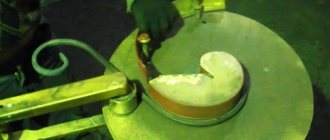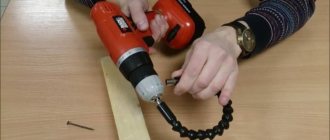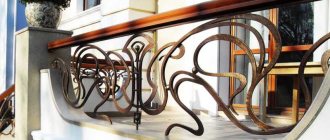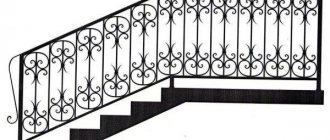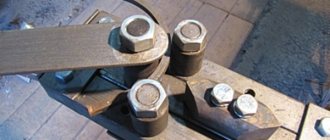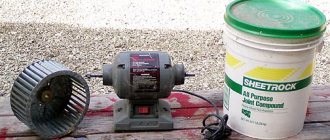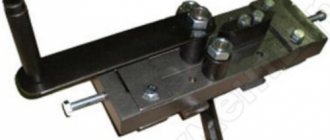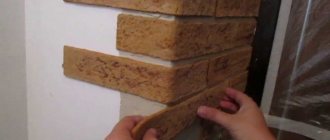Forged elements are in demand among clients of various categories . The parts have a variety of types, are sold at low prices, allow you to decorate various products and create interesting compositions, are easily attached to objects by welding, are easy to care for, are durable and have an attractive design.
A popular category of forged elements are curls of various configurations . They perfectly complement the design of small products for interiors and massive structures for the exterior of buildings.
Manufacturers offer a wide range of spiral elements. There is an alternative - purchasing or manufacturing equipment , which allows you to create curls of various types and sizes with your own hands.
What is used for bending, the entire list of equipment: universal, manual, matrix and others
Various equipment is used to produce curls using hot and cold technologies .
Mechanized machines
Special machines with electric drive and manual control . In practice, these mechanisms are bending equipment that allows processing workpieces from rods, strips and profile pipes of different sections. There are both universal machines designed for the production of various metal elements, and special ones suitable only for the production of curls.
Forging machine Azhur-1M. Photo ForgingPRO
Hand tools, dies, mandrels
The snail-type hand-operated instrument is popular and is a round table with a central leg. The structure of the machine also includes a double lever, the upper part of which is working, and the lower part is used for support, a jig or mandrel, located on the table and used for bending. Snails are often called dies, conductors and cold forging machines.
Cold forging machine Snail type Stalex SBG-30. Photo ForgingPRO
Other devices for cold forging are also popular among performers: wave, twister, globe, flashlight, hydraulic press. Manual devices are used for cold forging at home, i.e. in cases where the contractor does not care about the speed of production and the number of elements received . To increase productivity, the machines are equipped with an electric drive or motor.
In addition, various additional devices : forks, tongs, etc. Craftsmen often assemble non-standard models of tools and homemade devices, which have unofficial names.
In turn, for hot forging the performer will need a smaller set of tools, the main ones being a hammer and anvil, but a greater level of knowledge and skills.
Single-horned cantilever anvil. Photos Stankocentr
Types of equipment for manual cold forging of metal
To process metal products and create forged elements, special forging equipment is required. Enterprises produce a variety of mechanisms that facilitate human labor, speed up production and allow achieving high quality finished items. There are various machines for hand cold forging on sale. Before you learn how to make a homemade machine, you need to familiarize yourself with the mechanisms for arranging a blacksmith's workshop.
Snail machine
It is considered a universal device, which is intended for the manufacture of spiral-shaped products. Experienced blacksmiths claim that this is one of the simplest devices. The snail with a collar is made from a cast base on which a movable twisted conductor is fixed. Using the gate, the blacksmith begins to move the mechanism, and the workpiece is twisted in a spiral. Both cold and heated metal profiles and rods can be used as consumable raw materials.
A forging snail with a collar cannot be called a full-fledged forging equipment. This is a special tool that a blacksmith uses to make his work easier when making curled elements. It is easiest to work with heated workpieces. In this way, parts with a section radius exceeding can be used in production.
Torsion bar machine
This device allows you to twist several steel rods into one common piece. The design consists of a cylindrical base on which two twisting elements are fixed. The twisting parts are also clamps in which the workpieces are secured. Additionally, an electric motor can be installed that twists the rods to the required twist shape.
Gnitik machine
This is a classic manual cold forging machine. With its help, blacksmiths make any angle on workpieces. The design of the bend is a bending die with an eccentric drive. Additionally, they come with a template with metal rollers that are fixed on the frame. Various parts can be installed on the flex to expand its functionality.
Gnutik machine (Photo: Instagram / stanmann_ru)
Press machine
Many people who have worked in car repair shops or locksmith shops are familiar with presses. This cold forging mechanism can be assembled by hand. The machine consists of a cast frame and a piston mounted above it. An electric motor or gas drives a piston, which moves towards the working surface. The press is used to “bend” certain workpieces to certain angles.
Wave machine
With this device, blacksmiths create repeating twisted patterns (swirls with a small core). The design consists of two cast disks. They are secured to a metal base with bolts. In an improved version of the wave, it is possible to adjust the distance between the cast discs.
The principle of operation of the snail for winding forged curls, donuts and spirals
To perform bending of curls, it is necessary to prepare workpieces of the required sizes; depending on the processing technology, the parts should be heated or immediately started working.
Creating a curl for a baluster on a jig
The workpiece is placed in the jig, the end is fixed in a special cavity, and the rod is given the appropriate shape by applying force.
The following video shows this clearly.
DIY cold forging machine
Forging machines are available to anyone without special skills or expensive materials. Below we will describe how to make various blacksmith tools from available materials at home or in a small room, for example: a garage, basement.
Metal forging machines (Photo: Instagram / stanki_kovka_metalla)
Designing a cold forging machine: preparatory work
Before assembling mechanisms for the production of metal products, you need to prepare a drawing that will show the machine with key components. The drawing also indicates the fastenings and the dimensions. You can find a ready-made sketch of the equipment on the global network.
How to assemble a torsion bar cold forging machine
A homemade torsion bar machine will greatly facilitate the work of a blacksmith and save money. The assembly of the structure consists of several successive stages:
- First of all, you need to make a massive metal frame.
- The channel is fixed to the surface by welding the frame.
- A vise must be installed on top of the channel at one of its ends. They are designed for clamping rods.
- On the opposite part of the channel, it is necessary to secure the clamp on the movable rollers. The clamp itself can be made from a metal sleeve. It should have holes into which the clamping bolts are inserted.
- After securing the bushing to the rollers, handles are welded onto it so that the master can turn it, twisting the rods.
The bushing and vice should be located at the same level.
How to make a bending machine for cold forging
It is the simplest homemade machine. A structure for bending workpieces can be made from two metal shafts, a cast plate and a thrust mechanism. The shafts are fixed on both sides of a steel plate. There should be a rectangular hole between them. A movable stop is fixed in it. It is needed so that the master can choose the angle when bending the workpieces. When assembling the bend, parts made of tool steel are used.
Do-it-yourself snail machine for cold forging: design options
There are different options for creating coils for processing metal rods. Three popular ways:
- A snail of the desired shape and size is drawn on a metal table. For the finished drawing, you need to cut out metal plates of different thicknesses that repeat the shape of the snail. After fixing them on the drawn contour, the device is ready for use.
- Removable design with multiple bolts. Made from a round metal plate. Threaded holes are made in it for fastening bolts. With their help, you can change the radius along which the workpieces will bend. Also, thanks to the presence of holes, you can attach the coil to any desktop.
- More advanced design. A snail for cold forging is created with your own hands from a set of pre-made frames. They have different radii along which the workpieces will be bent. All that remains is to make a stable working surface and attach the prepared snail frames to it while working.
After assembling any of the presented options, you need to check the homemade device on rough blanks.
How to make a snail
Manual cold forging machines have earned respect among blacksmiths. The coil allows the production of small core curls, twisted fences and frames for garden furniture. A simple way to assemble a snail:
- On the metal plate you need to draw the outline of future bends.
- Thick sheet metal that can withstand heavy loads is attached to it using a welding machine.
- A vice is installed next to the machine to clamp one side of the workpiece.
The finished frame is mounted on a movable shaft, and handles are attached to the top. They allow the blacksmith to rotate the snail.
Anyone can make devices to make it easier to work with metals with their own hands. No practical skills or expensive materials are required to assemble it. You can place a manual machine in the basement or garage.
How to make a machine with a pattern for cold and artistic forging with your own hands
Making a curl jig with your own hands is quite simple. To do this, you will need a strip, a piece of sheet metal, a square and two small rectangular elements , one of which has a recess to secure the end of the workpiece.
These parts are welded at right angles and attached to the strip, which already has the shape of a spiral. The strip is attached to a small sheet of metal; a square is welded on the bottom side, providing fixation in a vice, or a leg for placement on an anvil.
You can see how to draw a spiral in the following video.
In addition, if you have knowledge about the structure and operating principle of devices, it is possible to make other devices with your own hands: a flashlight, a snail, a wave, etc.
Cold forging machines: application advantages
Machines for manual cold forging have significant advantages, for which they are valued by many blacksmiths:
- Making human work easier. Levers allow you to reduce physical effort when working with workpieces.
- After processing consumables on machines, higher quality and more accurate parts are obtained.
- To make your own machine, you don’t need to study and spend a lot of money on purchasing industrial mechanisms.
- Speeding up the production process. This is an important feature that allows the craftsman to produce more products for customers.
Human-controlled equipment does not require an electrical connection, which allows you to save on energy consumption.
Making a simple snail with your own hands
If you settled on a simplified monolithic design, then you know that this device uses simple winding of a rod by hand or using a lever onto a form rigidly welded to the working surface. This machine can be used to create curls on rods of small cross-section (less than 12 mm).
Monolithic non-demountable snail
It is made like this:
- First, a diagram of the future template with the required dimensions is drawn on a sheet of paper (sometimes the template diagram is applied directly to the base of the conductor). This must be approached responsibly, because after welding the finished form, it will not be possible to correct errors. The thickness of the outline of the form in the drawing should be the same as the thickness of the metal strip used for its manufacture. It should be at least 3mm. The coils must be placed at a distance of 12–13 mm from each other, so that a 10 mm deformable rod fits into the groove between them.
- The base of the snail (preferably round) is cut out of a steel sheet with a thickness of at least 4 mm, the diameter of which is determined in proportion to the size of the template spiral and be larger than the size of the snail. Typically the diameter of the base is within 70 cm.
- In accordance with the drawing, the desired curl shape is made from a 3mm thick metal strip. To do this, it is better to calcinate the workpiece so that it is easier to machine. After making the mold, the excess end of the strip is cut off, and the edges of the snail are cut into a cone and cleaned.
- The finished form is welded to the base, which is mounted on the frame. Sometimes a template welded to the base is fixed to the frame using yews installed on it. To do this, a piece of timber is welded to the back side of the base of the form for gripping with a yew.
With the option of fixing the conductor in a yew clamp, you can easily change the templates and obtain different shapes of curls if you make several types, monolithically welded to the base of the devices.
Removable design
- On the working base, first draw the contour of the snail with a mark along the contour of the holes for attaching the template.
- Based on the sketch, a template is made from a thick steel strip and holes are drilled in it. It is attached to the base with bolts.
Forging a twisted shape should begin from the central curl. The end of the workpiece is inserted into the groove of the first curl of the form and pressed tightly against it. You can use a small clamping tool to secure the fixation. With force, the free part of the rod is screwed onto the template using a device - a lever. Advanced designs use a lever driven by a moving bearing mounted on it. The lever is made of a rod with a diameter of 20 mm.
You can watch the making of such a device in the video:
Collapsible snails with rotation
The snail template can consist of several parts, and the deformation of the rod occurs by rotating the conductor. This machine consists of the following elements:
- thick metal base in the form of a disk or square;
- a collapsible template fixed to the base area;
- rotation shaft;
- lever to drive the shaft.
The working base is made of metal, with a thickness of 4 to 10 mm.
The prefabricated template may consist of several parts that are connected to each other by hinge pins inserted into the holes of the lugs welded to the ends of the elements. Together they make up the outline of the cochlea.
To attach such a snail to the working base, you need to drill holes in it to fix it to the surface in a certain position. By changing the position of the prefabricated parts on the base, you can obtain different curvature of the curls and their shape. The size of the arc of the shape is regulated by special screws attached to the connecting hinges.
It is quite difficult to make a composite volute with hinged joints yourself. Typically, craftsmen purchase a stamp made in an industrial environment and attach it to the bed.
You can make a simpler collapsible template device yourself without using hinges. To do this, you need to make a sketch of the prefabricated parts of the snail with the locations of the holes. If you prepare several sketches and, in accordance with their contours, drill holes in the base in different places, then you can attach templates with different radii to one base. To do this, you will need to bolt the contour segments where the holes of the template and the base align.
For example, you can do this:
A device with removable parts of the volute and a rotating cylindrical shaft driven by a lever is shown in the video:
